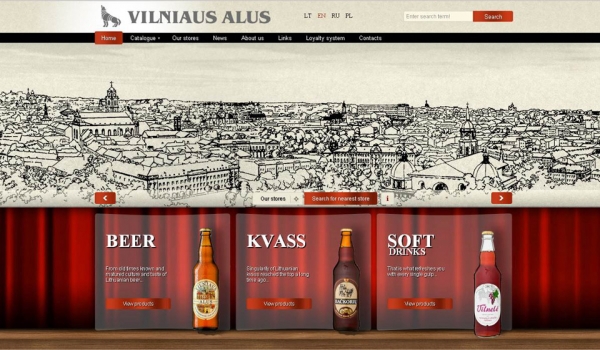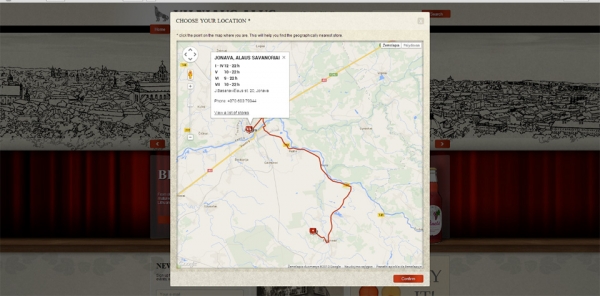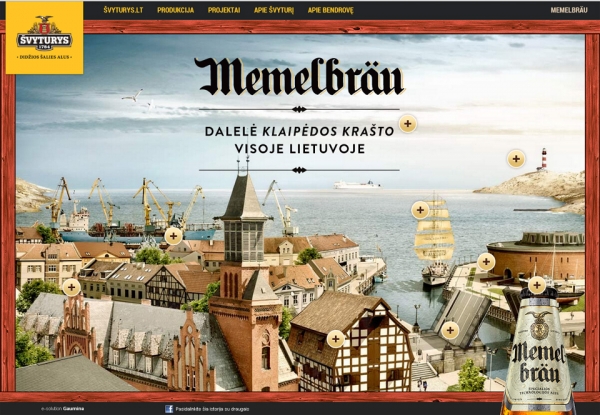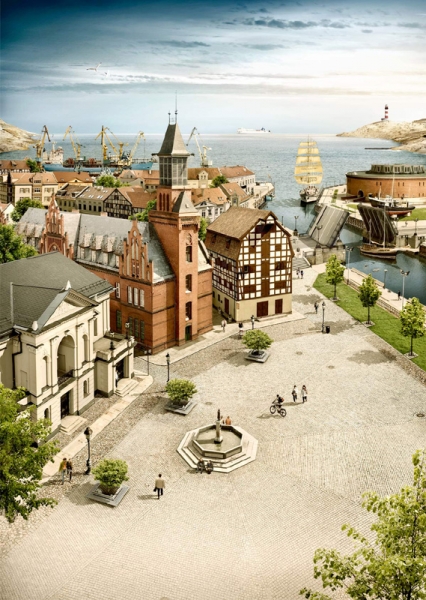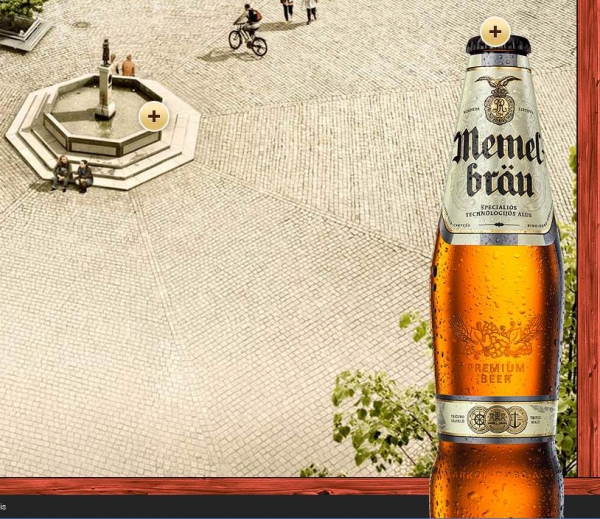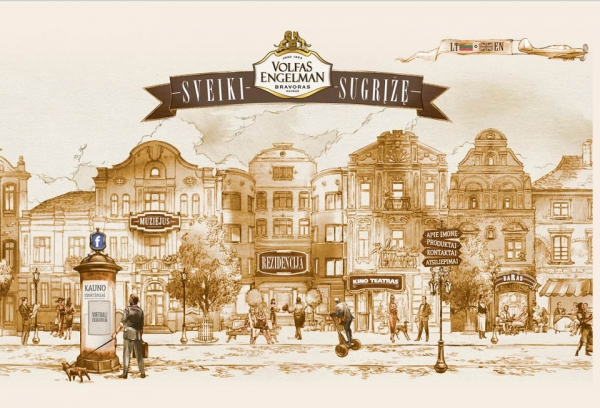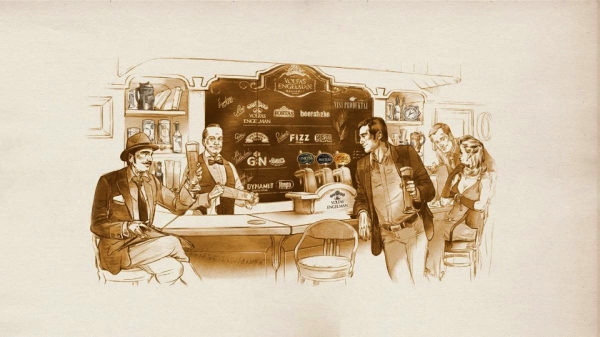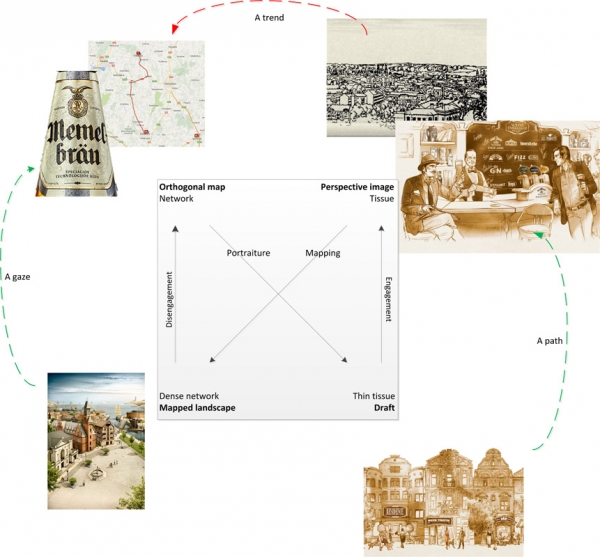Virtual places and spaces
analysis of Lithuanian beer-related web sites
Jovita Bružienė
Index
Keywords : map, network, orthogonal map, perspective, space, virtual space, web site
Auteurs cités : Algirdas J. GREIMAS, Eric LANDOWSKI, Louis MARIN, Félix THÜRLEMANN
The present dossier of the Actes Sémiotiques is dedicated to the concept of territory. And this article signifies an effort to join a common dialog and discuss the territoriality of spaces of particular type.
- Note de bas de page 1 :
-
Gertrūda Naktinienė, Jonas Paulauskas, Ritutė Petrokienė, Vytautas Vitkauskas, Jolanta Zabarskaitė (eds.), Lietuvių kalbos žodynas, (t. I–XX, 1941–2002) : elektroninis variantas http://www.lkz.lt, Vilnius, Lietuvių kalbos institutas, 2008, s. v. teritorija.
According to the Dictionary of the Lithuanian Language, territory is an area of a terrestrial surface1. The specificity of this definition is quite surprising – it in advance prohibits discussing territoriality of all extraterrestrial spaces (e.g., Mars), and also of specific kinds of virtual spaces such as internet sites, where life and inter-subjective relations may exist. However, we shall seek to analyze the spatial nature of virtual territories and different modes of their representation. What is more, despite its narrowness, the lexical definition seems to be not a bad starting point. If a territory is an area then its essence may be defined by the notion of boundary. And the latter supposes that a center/periphery criterion is relevant here. What is described by a border line is not a continuous space, at least for the reason that some points (or areas) of that space are further from the border than others. Thus one should discuss semiotic discontinuity of the space defined as a territory. On the other hand, the dictionary characterizes a territory as a plane. Hence, another topological criterion – top/bottom – seems to be useless at first. In Lithuanian, “territory” means a two-dimensional space that has boundaries and a specific topology, and the modes of its visual representation are presumably associated to cartography.
- Note de bas de page 2 :
- Note de bas de page 3 :
- Note de bas de page 4 :
The corpus of the survey is composed of three web sites of a particular kind, all representing beer brands. The fact that the object of this study is related to alcohol implies several peculiar nuances : i) Alcohol-related virtual spaces are legally determined to be inaccessible to a particular group of visitors – under-age persons. Thus, one can discuss insularity and territoriality of such spaces. ii) Beer producers often relate their production to the geographical place. We will discuss three brands that represent the three biggest cities of Lithuania : Vilnius (“Vilniaus alus”2 / Vilnius beer), Klaipėda (“Memelbräu”3) and Kaunas (“Volfas Engelman”4). We shall see how tight the relation between the brand and the geographical place is. One could even say that beer manufacturers seek to inscribe their name in the maps of those territories they represent (as if the brand would be one of the toponyms). Several different approaches of spatial representation are applied in the analyzed web sites.
The structure of this study is based on the criteria enumerated above. First, the general spatiality of alcohol-related web sites will be discussed. Then different modes of spatial representation in particular web sites will be examined by means of structural analysis.
1. Spatial organization of alcohol-related web sites
As it was mentioned, an abstract model of the beer brand representing web site is determined by the legislative base. Alcohol-related content in Lithuania is available only for adults. This formal limitation serves as the reason why site owners and creators are obliged to apply territorial approach when planning site structure and navigation. Web site becomes a space consisting of a center and its surroundings that are distinguished by a boundary line.
- Note de bas de page 5 :
-
Algirdas Julius Greimas, Semiotika, Vilnius, Mintis, 1989, p. 339.
The inner space of the web site is accessible only to persons who have certain qualities (who are of legal drinking age) while the surroundings may be visited by anyone who finds and clicks a link or knows the address – knows how to reach the place. Necessity to know how and to be able to act is presupposed by a third modality, willing to act. When the visitor enters the web site, he arrives from somewhere else, he travels and this defines him as a willing subject (according to A. J. Greimas, “travelling is a figurative manifestation of desire”5).
Although one arrives at the right address, the place is not the actual destination place yet. A site contains some inner space that is initially not available. A visitor’s arrival always covers a similar scenario and implements the canonic narrative scheme : if one is willing to enter the inner space of the site, he is obliged to pass the qualifying test (fig. 1).
Although the idea of an age test is always the same (a visitor has to confirm that he is adult), the particular implementations differ. In one of the analyzed web sites it is asked if the visitor is already eighteen years old. Impatience and expectation can be noticed in this formulation. In another example the question is presented in a more or less neutral manner : “Are you more than eighteen years old?” The adverb “more” unobtrusively prompts the right answer. In latter implementation the question is available only in Lithuanian (while other web sites are translated into English). Hence the visitor is able to pass the qualification test only if he knows the local language. The locale of the site is defined by the country code (“lt”) in the site address and in this case links virtual space to geographical place very closely. The third web site provides an even more general formulation of the question – the visitor is inquired if he is “of legal drinking age”. Thus non-Lithuanian visitors are free to answer according to their (not necessarily local) legislation system and system of values in general.
The age test’s implementations also differ visually (fig. 2). In the first case, some indistinct outline of a city can be seen. The visitor cannot cross the boundary before he passes the test, but he is still able to visually examine the space he is eager to enter. This approach correlates with the question’s impatient formula. In two other implementations the background is opaque and covers the inner space of the site.
The traffic between the surroundings and the inner space is controlled by an anonymous arbiter who decides whether the visitor has a right to cross the boundary.
If the sanction is negative, the arbiter answers with some standard message about Lithuanian law. It informs the visitor about the properties needed to pass the test – only adults (“persons not younger than 18”, “people from 18”) are allowed to enter the site. On the narrative plane, this hint allows the subject to substitute the necessity to be able to act with the modality of knowing how to act (knowing the right answer). If not present yet, that knowledge can be achieved here, in a paratopic space of the site surroundings. The visitor is free to try entering the forbidden site space as many times as he wishes, he even does not have to reload the browser to try again and again.
The space of a site surroundings resembles a crossroad with one way leading to a dead-end. The visitor cannot choose a third direction, he has to turn right or left – “No” or “Yes”. When he turns to “No”, he gets to a deadlock, this leaves him no other way than to turn back (refresh the page) and turn to “Yes” or – depending on his will – leave the web site.
The visitor can cheat and trick the arbiter, because the relation between them is one of anonymity and confidence : the arbiter does not know how old the visitor is, since the latter has never bothered to introduce himself.
However, the idea of anonymous access is not implemented fully. The visitor often has a possibility to choose if he wants the arbiter to remember his answer or even his identity (checkboxes “remember my choice” and “remember me on this computer”). Hence the arbiter has the means to identify the visitor without asking his name.
Once the checkbox “remember me” has been checked and the test has been passed, the border between the site surroundings and inner space of the site disappears and is never seen again. The inner site’s space becomes open for the visitor – the arbiter recognizes and lets the visitor in whenever he arrives to the address which is the same for the site and its surroundings, because these two spaces are defined as one place – one territory.
The space of alcohol-related web sites seems to be non-continuous – it is structured according to the criteria of center and periphery, the border between these two spaces being passable only for a qualified subject. The transition from the surroundings to the center can be done without naming oneself. Still, some of the visitor’s private information (his IP address and declared age) is stored. But he is not strictly speaking identified by this information, he is rather qualified by it. So, the access is non-anonymous. In this case, the relation between the visitor and the owner of the site is a relation of confidence.
If we would try to define other possible ways of spatial organization of virtual spaces, we should also pay attention to those cases when the visitor is obliged to introduce himself to pass the boundary. This is usually done by the means of registration and contract (legal agreement) : the visitor submits some private information about himself and gets the password. He is the one who knows the password and the one who knows the password is him. There is such a type of access when login is required and the space of the site and the surroundings is strictly divided, discontinuous.
By contrast, in a continuous (not divided) space everyone can move freely, there are no borders, only paths (pages can be browsed through). This is the way the majority of web sites with anonymous access operate.
Logic demands to define one more spatial category – non-discontinuous space that does not require, but permits registration. This kind of space is nearly continuous, but the visitor cannot move in it freely while not logged in, e.g., one is allowed to read anonymously just a part of the content and needs to register to get it all, but the space where one reads either just a part or the full article is the same space.
The discussed terms illustrate different possibilities of inner organization of web sites by opposing open and closed spaces.
Alcohol-related web sites appear in the right bottom corner of the semiotic square (fig. 3) and belong to the class of not-open, non-continuous virtual territories divided by boundaries that can be crossed by means of qualifying tests passed by the visitor.
2. A room with a view and other spatial games
Spatial organization of alcohol-related web sites interestingly correlates with the meaning of the word “site” itself. While the English term “site” signifies an outer space, the Lithuanian word “svetainė” refers to the inner space of the accommodation and means a living-room, a place that is intended for guests (qualified site visitors that come for a time) and is neither absolutely public, nor strictly private (therefore not-open).
A spatial and territorial approach is used not only in an inner site organization, but also in the visual content of the web sites. As already mentioned, beer producers often relate their brands with names of outer spaces – cities or regions. Thus a beer-representing web site is predefined to be a not-open, inner space with an outer space-related content – a room with a view!
- Note de bas de page 6 :
-
Here and further notions of different regimes of space, such as tissue, network, abyss are used as defined by Eric Landowski in “Régimes d’espace”,NouveauxActes Sémiotiques, 113, 2010.
Three web sites and their relations to external geographical places will be discussed further. “Vilniaus alus” and “Volfas Engelman” brands represent beer producing companies and “Memelbräu” a particular beer. The focus is laid on combinations of conceptual and visual aspects of territories beer brands relate themselves to and on ways how the user is involved into the space of those territories by applying operations of enunciative shifting – engagement and disengagement (or embrayage and débrayage). The spatial nature of the depicted places is examined with a reference to the typology of regimes of space proposed by E. Landowski6.
The first brand – “Vilniaus alus” – describes itself as “the only brewery and soft drinks producer in Vilnius, the capital city of Lithuania”. The interior of the site implements the idea of a living-room quite literally. After a successful test, the entrance to the inner space of the site immediately opens and the visitor finds himself in the center of a room with a windowsill, a curtain and a wide panoramic window overlooking Vilnius (fig. 4).
- Note de bas de page 7 :
-
Vladas Drėma, Dingęs Vilnius, Vilnius, Vaga, 1991, p. 74.
Everyone who has ever seen the city from this perspective would recognize the place where the observation point is located – it is on the top of the Gediminas hill in the historical center of Vilnius. Although the observation point seems familiar, the city outline differs from nowadays. “Vilnius Panorama from the Tower of Castle Hill”7 made by J. Grutzka in 1917 is nearly a century away from the visitor’s hic et nunc. Thus, in terms of temporality, the viewer is disconnected from the utterance : now becomes then and I is substituted with the third person – the view is actually seen by someone else’s gaze.
It is worth noticing both the position of the viewer and the nature of the view. On one hand, the observer occupies quite an advantageous, dominating central and top location – he is overlooking the city from a steep hill. On the other hand, this position does not supply the viewer with a total, exhaustive knowledge – the buildings overlay each other, something is seen and something is hidden from the gaze. This inconvenience arises precisely because the view is seen in perspective. The perspective nature of the image presupposes that the observation point and the view both belong to the same space. The visitor himself participates in the space he is watching. Thus initially the viewer is shifted-in into the space of the utterance. The function of enunciative engagement is at first fulfilled by the implicit figure of the viewpoint but next it is denied by the temporal status of the panorama.
The inconsistency between the temporal and spatial makers of enunciation interestingly influences the visitor’s ability (or rather disability) to act in the space he occupies and observes. One cannot examine the panorama all at once. At each moment one can see only a part of the city. When the mouse pointer is being moved left or right, the image scrolls aside – this is how movement of looking around is simulated. With the help of the mouse the visitor is able to explore the view in 360 degrees, but he never sees the panorama as a whole. Thus the full, exhaustive knowledge about the city is never accessible. Moreover, the motion of the viewer is quite constrained as he cannot zoom in or zoom out.
Not to mention that the view itself is too dense to be fully examined from a distance – every element is related to other elements, the space resembles a thick tissue in which every thread is inwrought with other threads. Thus any action causes an equal reaction in such space and the performer must be quite wary and smart to succeed in reaching his goals. He also needs to have special knowledge about the rules and regularities that exist here. But that knowledge is inaccessible, the city is too far to distinguish all the connection. So, the subject’s gaze is constrained to stay in a static, synoptic (and safe) position and does not ever become a travelling gaze.
Though the visitor of this web site cannot take a trip around Vilnius, he is offered to play a spatial game of another kind – to find the geographically nearest beer store. To do this, the visitor is proposed to point his current location on the actual map of Lithuania. The presumption that the current location of the visitor still needs to be identified (and is elsewhere in Lithuania, not on that hill he is looking from) supposes that the actual viewpoint is occupied by some other performer (it is seen by someone else’s gaze as we said earlier).
The current map of the country that is opened in a popup window is something opposite to the past-related profile of the city seen on the homepage of the site. It seems that orthogonal projection of the map is linked to the present in the same way as the perspective city view is mapped to the past tense. Moreover, two modes of spatial representation mark opposite modalities of enunciation – disengagement (orthogonal view) and engagement (perspective image). The gap between these two representations is visually expressed by the opening between the homepage window and the popup window.
The orthogonal projection implies that the gaze of the observer is situated outside all viewing points, that it does not belong to the examined space and that the mapped surface can be simultaneously seen from everywhere and from nowhere. On one hand, cartographic representation offers full, exhaustive knowledge about the space – nothing is concealed from the gaze of the viewer. On the other hand, a cartographic text is full of explicit ellipses. Only relevant figures are rendered and others (seemingly irrelevant) are passed over in silence. Here we have to notice that such a map differs from the previously seen panoramic view in one aspect : a space mapped is not a dense tissue, it is actually a network connecting a finite number of selected points. The relation between an orthogonal map and a perspective image seems to be defined by the opposition of non-discontinuous (network) and continuous (tissue) space.
- Note de bas de page 8 :
-
Felix Thürlemann, “Paukščių akimis: sakymo struktūra tam tikros rūšies geografiniuose žemėlapiuose”, in Baltos lankos, 30, Vilnius, Baltos lankos, 2007, p. 59. (Translated from the French : “Regarder avec les oiseaux. Sur la structure d'énonciation d’un type de carte géographique”, Nouveaux Actes Sémiotiques, 112, 2009).
But let’s return to the popup window and the map of Lithuania in it. As we have already noticed, the viewer is not fully involved into this utterance. At first, his gaze is synoptic. The anonymous sender invites the visitor to click the point on the map where he currently is. This action – placing oneself on the map – is the beginning of a transformation : the synoptic subject selects the starting point and turns into a travelling8 and willing subject. And here the manipulation comes – the future traveller is given a route. He does not choose a route himself, someone else grants him the spatial competence by prompting him on how to act. The anonymous sender not only selects the destination point (“the geographically nearest store”), but also is kind enough to draw the itinerary on the map (fig. 5). The given route is actually a proposition, a contract that can be established between the sender and the subject.
If the subject rejects the proposal, he is free to leave (by closing the popup window). But if the offer is accepted, he will have to confirm his decision (figuratively – to push the confirmation button). The button closes the popup and additionally invokes causing-to-know of the instance of the Gediminas hill – the sender. When the button is pushed, the visitor is returned to the homepage and something unexpected happens – the panoramic view of Vilnius starts to scroll toward the direction to the point formerly chosen on the map. It is not the visitor who is looking around (because he placed himself somewhere else on the map of Lithuania), it is the instance of the hill that turns “toward you from Gediminas tower” – this gesture marks cognitive sanction of the sender (recognition). The execution of the contract is finished by providing the subject with the knowledge implicitly present in the map: “From you to the nearest store 12km” (fig. 6). Hence not only a link between the subject and the sender (“trend toward you”) is being created, but also a connection between the subject and the object of value (“from you to the nearest store”) is being built. The link between the two contracting parties signifies temporal connection between the sender then (past depicted in perspective – 1917) and the subject now (orthogonal present – 2013).
- Note de bas de page 9 :
-
Algirdas Julien Greimas, Maupassant. The Semiotics of Text, Amsterdam, Benjamins, 1988, p. 229.
The trend of the gaze is something that invites the synoptic subject of the panorama to become a travelling subject once again. But the objective (to find a passage from the Gediminas hill “toward you”) is impossible to reach, because the distance between a panoramic view and an orthogonal map is not known (in contrast with the distance “from you to the nearest store” that is expressed in measured units of distance). Moreover, it is not passable – a gap opens between these two spaces (visually, between the main browser window and the popup). It reminds those “tiny little waves”9 in Greimas’ analysis of Maupassant. The opening between Gediminas hill in 1917 and the visitor’s hic et nunc seems to be the gap between the cosmic plane and the human plane, as such impossible to cover by the gaze of a mortal.
The second web site represents the beer brand called “Memelbräu”. Currently (in late 2013) this beer can be purchased everywhere in Lithuania, but initially the producer sought to implement quite opposite marketing strategy : for several years Memelbräu declared that it was not a beer that pandered the consumer, but one that pushed the customer to move towards it. The initial insularity of Memelbräu was clearly illustrated by the fact that the web site did not have English version. It was intended exclusively for Klaipėda region native people who spoke Lithuanian. This beer’s relation to place is encoded in its name : Memel is the old name of the city of Klaipėda, officially used till 1945, and Memelbräu means “beer brewed in Memel” or “Memel beer” in German. Thus Memelbräu was presented as a beer created and brewed by Klaipėda people for Klaipėda people and small supply of it corresponded to a small share of the market. If one wanted to try this beer, he ought to travel to Klaipėda, because the product was offered and available only in this region. And that was declared in the heading of the web site – Memelbräu was defined as “a small part of Klaipėda region”. Recently an additional line appeared in the heading and Memelbräu became “a small part of Klaipėda region in all Lithuania“.
The web site representing this beer in some sense reminds the one analyzed earlier since it also alludes to a room with a huge window that overlooks some urban landscape (fig. 7). The view initially is seen from above, the gaze of the viewer is dominating and fixed (thus involved into the space of the utterance by means of perspective depiction).
A further relation between the viewer and the view depends on the spatial competence of the observer. In the “Vilniaus alus” case special knowledge allowed the visitor to identify the temporal inadequacy between the time of the utterance and the time of the enunciation. In the “Memelbräu” case anyone with a proper knowledge notices another spatial mismatch – that realistic panorama seen from above is fictional. Though the figures are portrayed properly, the relations between them are depicted wrongly. This “portrait” of the city is rather the result of some cognitive reconstruction than of portraiture.
Visually, the scene seems very similar to the panorama of Vilnius in the previous web site (it looks like a dense tissue). The difference lies in the conceptual aspect of the depicted place. Various objects representing Klaipėda region appear as landmarks and are gathered and stuck together here. Though several kilometers separate those objects in reality, in the panorama the distance is reduced to zero and covered by implicit ellipses. So, while the space of the region is visually represented as a tissue, it operates like a network of selected relevant points – a dense network. All the points are marked with a special symbol – a circle button with plus sign in the center. Each of these buttons open a verbal description of the landmark in a popup window. The spectator is deluded by the mimetic nature of this net. Only the knowledge and experience can prompt him that this is not a real panorama but some complex type of spatial representation that has to be clarified yet.
A beer bottle (“a small part of Klaipėda region”) participates in this panorama and becomes another city tower, the nearest object to reach and the possible viewpoint. Initially only a bottleneck can be seen. The visitor has to scroll the page down if he wishes to examine this landmark. This movement involves the viewer into another spatial game : when the mouse pointer is moved towards the beer, the panoramic view starts to scroll down, simulating the movement of looking over. To examine the bottle the visitor is forced to overlook the view of the region. This sequence (see the region —> get the beer) coincides with the initial marketing strategy (come to Klaipėda —> buy the beer).
- Note de bas de page 10 :
-
Louis Marin, “The City in Its Map and Portrait”, in On representation, Stanford, Stanford University Press, 2001, p. 213.
- Note de bas de page 11 :
-
Svetlana Alpers, “The Mapping Impulse in Dutch Art”, in David Woodward (ed.), Art and Cartography. Six Historical Essays, Chicago, The University of Chicago Press, 1987, p. 75.
- Note de bas de page 12 :
-
Ibid., p. 72.
- Note de bas de page 13 :
-
Ibid., p. 76.
When the view stops scrolling, it turns out that the observer’s perspective slightly changes. His point of observation is not fixed anymore, but “is both absolutely dominant, as in the map, and openly fictional, as […] in topographic views”10: he is looking from what is referred to as a bird’s-eye view (fig. 8). This mode of representation supposes a “curious mixture of distance preserved and access gained”11 and marks “the transformation of a mapping mode into landscape”12. Hence, the complex type of spatial representation used to depict Klaipėda region is nothing else but a mapped landscape. This relation to cartography is also confirmed by the “extremely high horizon […] and the designation of the landmarks”13.
After scrolling to the very bottom of the page the observer still is not able to examine the bottle of Memelbräu fully. The very bottom of it is cut. It seems that the bottle neither belongs to the inner space of the site nor to the space of the panorama and stays somewhere in between, in the gap, out of reach of the visitor.
- Note de bas de page 14 :
-
Louis Marin, op. cit., p. 211.
The mirror-image of the site visitor examining the bottle is depicted in the panorama : a stranger is sitting nearby a fountain in the center of a city square (fig. 9). Though he has plenty of water nearby to quench his thirst, his soulful look is turned towards the beer. The stranger is looking from below (opposite to the visitor who is examining the view from above). He resembles “a person who figures on the represented stage, in the portrait of a city ; […] the city’s viewer from outside the scene”14.
It is a curious situation. The bottle comes to be the object of interest both for the site visitor (the producer of the enunciation) and the visitor of the Klaipėda region (the delegate of the enunciation) – something the viewer of a city is looking at. But why does it grab the attention?
The thing is that the label of the bottle has some resemblance to an orthogonal map. Cartographical esthetics is used in the design : a “fraktur” typeface and striped border, looms of some territory in the background, place-names, armory and orthogonal projection.
The configuration of the placenames present in the label (“Klaipėda”, “Lithuania”, “Memel”) is made according to the criteria of center and periphery. Proper nouns “Klaipėda” and “Lithuania” are used nowadays, the first marks the city and the other the whole country. They belong to the marginal space in the label whereas “Memel” and the brand name, “Memelbräu”, are placed in the center of the mapped place. In this “map” the beer is literally marked as the central part of the territory while in the panorama the bottle is depicted as one of the many city towers – only “a small part of Klaipėda region” (according to the heading).
Thus the label of the bottle not only contains a map – an essential tool for a traveller, but also reveals something that is otherwise invisible – the real spatial configuration of the region (and the ideology covered underneath). In this case the map functions as an optical device, a lens. The gap between the beer and other figures in the panorama signifies the shift from the space of pseudo-operation (a mapped landscape - very dense network, almost a tissue) to the space of manipulation (an orthogonal map, a network of relevant points). This shift is overpassed by the gaze of the traveller.
The last web site belongs to the “Volfas Engelman” beer brand. Once again, it associates itself with a particular city and it’s past. The visitor of the site finds himself on a street of interwar Kaunas (fig. 10). In that period, the city used to be the provisional capital of Lithuania (thus the ideological center of the State) and Volfas Engelman was the biggest brewery in the whole country.
What differs in comparison to the previous sites is the manner in which the city is depicted. On one hand, the view of the street seems realistic, mimetic. On the other hand, something is wrong with the depth – although an allusion to perspective is noticeable, the street still looks flat.
The view is not static. Just slightly move the mouse and the illusion of perspective and depth disappears. The view starts to scroll left or right depending on the direction of the mouse movement and one can notice that the space depicted in this view is made of three separate layers that move independently (the sky, the facades, the street).
The medium layer – facades of houses – reveals itself to be an orthogonal image – a draft. This plain representation of the surface of geometrical body demands the same gaze as an orthogonal map – the viewer is disengaged from the space of the utterance and is supposed to see all the details of the mapped place. But the essence of the depicted place differs from mapped ones. The facades are closely linked – the space depicted by a draft is a space of continuity, a thin tissue that visually resembles a network.
The layering brings some side effect and involves the visitor into a new play : the objects belonging to the upper street layer cover the deeper ones. Thus even the orthogonal projection does not warrant that the view is comprehensive as in maps.
The movement of layers reveals gaps between them. There may be a path or an abyss in between – the visitor cannot know until he oversteps the edge of the first layer. This knowing that one does not know may be the motive that would encourage the visitor to act.
Like in Memelbräu’s site, we can notice the delegate of enunciation – a man with a segway on the verge of a ruin. The visitor is being tempted to follow the curious one and to dare examine the space of the facades on the other side of the gap (click the links on the signboards). It is easy to guess what he finds inside : an empty seat in a bar and the inviting smile of a barman already wiping a mug (fig. 11). By walking into the bar, the visitor crosses the boundary between orthogonal and perspective image and this illustrates the enunciative shift-in. He also moves from the outer space with a view to the inner space of accommodation (opposite to the previous examples where the initial location of the visitor was a room with a view).
Concluding remarks
It seems clear that some Lithuanian beer brands construct their web sites as not-open virtual places with some outer space related content and quite literally implement the idea of web site as of a room with a view – or the contrary, a view with a room in it. The visitor is proposed to experience a brand-related urban space in several different ways. Exploring that space usually leads to the object of value – the beer.
Two main techniques of spatial representation – portraiture and mapping – are used to depict the brand-related territories.
The result of the first technique is usually a topographical city view – a panorama that is represented in perspective and mimetic manner and is seen from above. The figure of the fixed viewpoint (implicit or explicit) supposes that the viewer belongs to the overlooked space and is shifted-in within the utterance. The space of the place depicted in the panorama is usually continuous (both visually and conceptually). It reminds a tissue and operates according to some regularity. Thus, acting in this space demands a special knowledge of its rules (at least some spatial competence) and a direct contact.
The mapping technique represents the opposite space regime, which is defined by the non-discontinuity of the depicted space. The map represents a network of relevant points that may be linked or not. Such view is usually rendered in orthogonal projection : the land is seen from above and the figure of a fixed view point is absent. The space is observed from everywhere and from nowhere simultaneously and the observer does not belong to it, he is disengaged from the utterance.
Opposing these two modes of spatial representation allows us to define additional categories : i) a mapped landscape - dense network in which gaps between points are present, but not visible ; ii) a draft - thin tissue that resembles a map because of an orthogonal projection, but defines a continuous space.
In the “Vilniaus alus” web site we are dealing with a topographical city view drawn in perspective and an orthogonal map of the country. As seen in the schema below (fig. 12), no logical path from one to another exists. This inability to cross the gap between perspective image and orthogonal drawing is illustrated by the trend from the first towards the second. Even the sender’s gaze cannot pass that gap, but the trend is something that creates a relation between two planes.
In the case of “Memelbräu”, the relation between mapped landscape and orthogonal map is created by the gaze of the willing subject. The operation of visual disengagement leads from one regime to the other.
In the web site of “Volfas Engelman”, the gap between a draft and a perspective image is passable, but the subject has to be curious enough to step into the inner space of the bar. This relation is figuratively represented by the virtual path (the link) between two planes and implemented by the means of enunciative engagement.
Sources of illustrations
Figures 2, 4, 5, 6 – http://www.vilniausalus.lt.
Figures 2, 7, 8, 9 – http://memelbrau.svyturys.lt.
Figures 2, 10, 11 – http://www.volfasengelman.lt.
Other – by the author.



